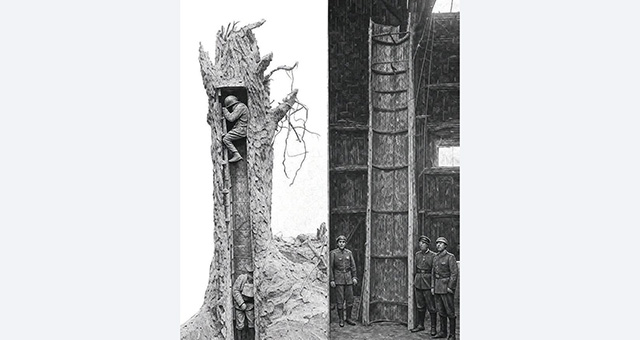The Tree Observation Post
In the chaotic, mud-drenched trenches of World War I, survival often depended not on brute strength, but on information — knowing where the enemy was, what they were doing, and what might come next. But how do you spy on the enemy without being seen? Enter one of the most astonishing tactics of the war: the Tree Observation Post — a fake tree with a soldier hidden inside.
What Was a Tree Observation Post?
These posts were ingeniously disguised observation towers. They looked like dead or damaged trees — twisted by artillery, scarred by time — but in truth, they were carefully constructed steel cylinders, with just enough room inside for a soldier to sit, watch, and report enemy movements.
The trunk was hollow, the exterior painted and textured to look exactly like a real tree. Even under daylight, enemy scouts and snipers were often fooled.
How Did It Work?
Under the cover of night, engineers would cut down a real tree that had a strategic view.
Then, they’d replace it with a fake tree, custom-built to match the original in appearance.
The soldier would enter through a trench or concealed tunnel.
Inside the tree was a narrow viewing slit or periscope that allowed the observer to monitor the enemy without ever being seen.
This information — about artillery placements, troop movements, and logistics — was relayed back to command, shaping battle decisions with near real-time intel.
Where Art Met Warfare
These observation trees weren’t just clever — they were works of art and engineering:
The French were the first to deploy them in 1915.
British and German forces quickly adopted the concept.
Artists and sculptors were hired to make the bark, knots, and broken limbs visually indistinguishable from the real thing.
Each tree could take up to 72 hours to build and install.
They were often crafted from steel and wood, designed to withstand bullets and light shelling — though being discovered usually meant certain death for the soldier inside.
Risks and Realities
Being inside one of these fake trees was incredibly dangerous:
The soldier had limited movement, poor ventilation, and was completely alone.
If spotted, the post would become an instant target for enemy fire.
Many observers rotated in shifts to avoid fatigue or mental breakdown.
Still, the strategic advantage they offered was immense.
Why It Still Matters Today
The Tree Observation Post is a powerful reminder of the intersection between creativity and necessity in warfare. It shows us how ingenuity, art, and tactical brilliance can thrive even in the bleakest of circumstances.
Historians continue to study these structures as examples of early military camouflage, stealth, and adaptive battlefield engineering.
Sources
Imperial War Museums (IWM), UK
The British Army in the Great War (The Long, Long Trail)
National World War I Museum and Memorial

